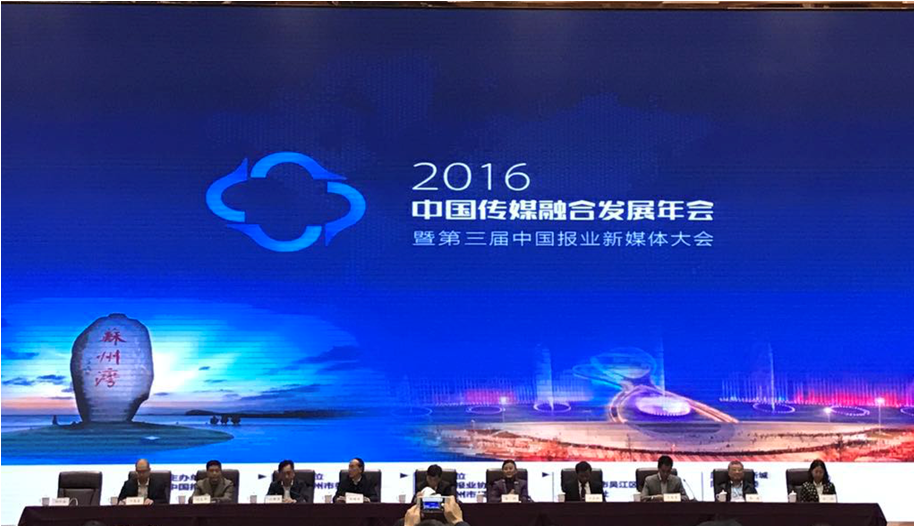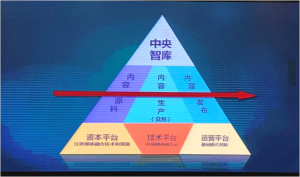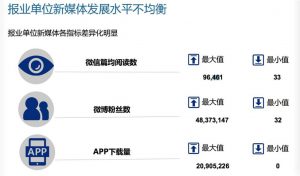
December 1, 2016, by Tony Hong
Behind China’s Media Convergence Campaign
By Dan WANG,
Ph.D Candidate, Hong Kong Baptist University.
Media convergence has been proposed and reinforced by the central government since 2014. So far, most newspaper organizations at all political levels have acted upon the call by equipping their newspaper with the standard set of Liangwei Yiduan (两微一端) (one official WeChat account, one weiblog official account and one news app). Two years later, on November 12th 2016, a group of media related central government officials and newspaper chief editors from different parts of the country gathered in Suzhou at the Media Convergence and Development Conference to share their convergence experiences. Based on 32 reports from the conference, this entry will offer an analysis of the meaning of media convergence in China.
Media convergence is first and foremost a political strategy. The concept was raised to a national level “strategic plan” by President Xi Jinping in August 2014[1]. However, both Chinese media practitioners and scholars from the conference believe that the real engine that drove all media to take real actions upon the convergence call was premier Li Keqiang’s concept of the “internet plus” in the 2015 Government Report[2]. As “internet plus” was primarily considered as a development strategy for the e-commerce industry, this idea brought hopes to press group managers of economic profits. This year, the concept has appeared in all sorts of governmental reports and policies, including the newest 13th five-year plan[3]. Therefore, many talks in this conference started by introducing media convergence as a project “guide by the central government, and enact by the local press groups” (Wang Jiasi; Huaibei Daily).
The conference revealed a big gap of understanding of media convergence from the top-down governmental voice and bottom-up media outlet managers.
For central government officials (eg. Ma Li, Head of the Development Foundation of National Cyber Information Office; Ding Zhiyong from SAPPRFT; and Wang Jiasi from the China Press Association) and central media representatives (eg. Ye Zengzeng from the People’s Daily), media convergence means occupying the online discursive battlefield. They recognized the importance of audience’s interests not because of the value of democracy, but because “the Party is always with people, no matter where they go” (Ma Li), and now most of them are online. Ding Zhiyong reiterated three speeches Xi gave in 2016, i.e. “2.19” talk on media’s mission of guiding public opinion (transformed from the party mouthpiece) in the digital age, “4.19” talk on cyber security and “11.7” talk on value of “four correctness” of being a journalist, which shows the centralization of one party control over media and media workers. The centralization is particularly observable from the talk Wang Jiasi conducted, which directly called for a “consciousness” of “yours is mine, mine is yours” new media value. He believed that the ultimate map of media convergence is to realize “media communism” in China, which is also his understanding of Xi’s proposal of “converging as one” in his talk in 2014.
People’s Daily took a pioneer step by operationalizing the “converging as one” philosophy into a system of “central kitchen”. In this system, a database built by the central government will generate “raw materials”, which are open to be purchased in the market by all types of information organizations including local media outlets (See the hierarchy table below). Although all media organizations can contribute to the central database content, the gatekeeper has elevated from editors of one media outlet to someone possibly from the central government. This way of making news could tackle three major issues that have bothered the Chinese leadership with one array: 1) the information domination could help the government occupy the online (and offline) discursive platform; 2) no matter how fragmented the internet audience are, there will be only one content database; 3) the central level media outlets could gain absolute privilege, because the internet breaks the territory boundaries, which renders local news, with relatively smaller social focus, less likely to be spread (as local news normally only related to certain audience).
(Ye, People’s Daily, 2016)
However, media convergence is interpreted quite differently from the local leveled media groups/organizations. From what have been presented and discussed during the conference, media convergence does not contain real meaning in terms of the production of journalism to most local press groups. It was not what media organizations wanted originally, but more like a digital reform pushed by the governmental policies and technological development. For the policy part, besides Xi-Li talks on media convergence and the internet plus, the central government has issued a series of plans, that come along with grants, to facilitate the speed and process of convergence. They include Suggestions on Facilitating Traditional Media and New Convergence by SAPPRFT and the Ministry of Finance in 2015[4], 2015 Working Plans on Supporting Mini E-commerce in Cultural Industry by the Ministry of Culture[5], the Outline of Boosting Big Data Development[6] by the State Council in 2015 and so on.
As for technology, according to a report released on this conference by the China Press Association, 96.5% of media organizations that they conducted research on are somehow “online”. However, the report also shows an unbalanced development of online platform in terms of content. The picture below demonstrates that, for all researched media organizations, those who have WeChat accounts attract followers ranging from a maximum of 96,461 to 33 at a minimum, the weblog ranges from 48,373,147 to 32, and the app from 20,905,266 to 0. These numbers tell more than just the numerical discrepancy. They also prove that (some) media outlets (still) do not want/understand the meaning of convergence, so that some of them fail to maintain and promote their digital platforms.
(China Press Association, 2016)
Media convergence makes “producing journalism no longer the main responsibility of media outlets, especially local media outlets.” The report released by China Press Association shows that, only 0.2% of the WeChat content of all researched media outlets were original. As general secretary of China Newspaper Cultural Industry Alliance proposed, all media outlet managers should to manage their newspapers by designing a suitable superstructure for selling the service instead of content. This is because, as he justified, media outlets are facing 5 dilemmas: 1) untouchable hope (i.e. the government has encouraged media organizations to converge to digital platform by telling them that there’s a prosperous future there, but most local media have not experienced it), 2) hardship for real transformation (i.e. it is impossible to realize freedom of expression from the online society, journalists are still dancing with fettlers), 3) danger of working as a public unit (Tizhi) (i.e. it is just like the sword of Damocles, you never know what will happen in the next minute), 4) hardship of party-corporation (i.e. hard to decide whether to play the edge ball or not), 5) fight over the central kitchen (i.e. hard to maintain guanxi with other media outlets under this idea). All these five dilemmas somehow forced media organizations to go for another path of survival, i.e. joining/monopolizing the local service industry.
[1]http://www.gapp.gov.cn/news/1656/223719.shtml
[2] http://lianghui.people.com.cn/2015npc/n/2015/0305/c394298-26642056.html
[3] http://www.china.com.cn/lianghui/news/2016-03/17/content_38053101_20.htm
[4]http://www.mof.gov.cn/mofhome/he/lanmudaohang/zhengcefagui/201504/t20150413_1215711.html
[5] http://www.gov.cn/zhengce/2016-02/02/content_5038407.htm
[6] http://www.gov.cn/zhengce/content/2015-09/05/content_10137.htm
No comments yet, fill out a comment to be the first



Leave a Reply